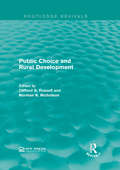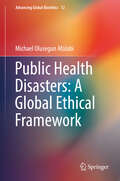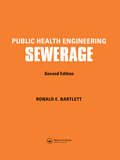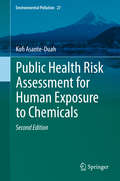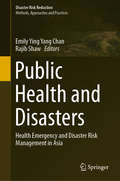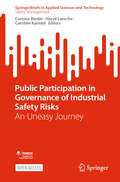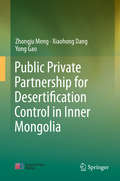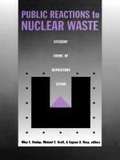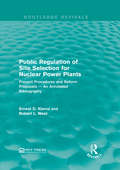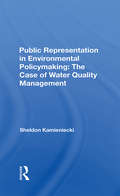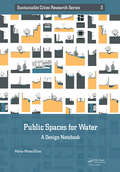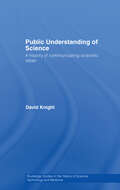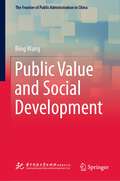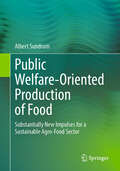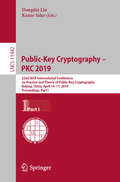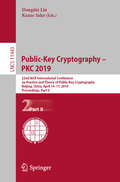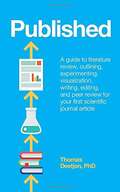- Table View
- List View
Public Choice and Rural Development (Routledge Revivals)
by Clifford S. Russell and Norman K. NicholsonThis title, originally published in 1981, explores the difficult, and at times volatile, relationship between public choice and rural development in developing countries. The book is organised into three major sections: the first section examines important general themes, the second describes how public choice and rural development intertwine in some areas of concern to aid donors, and finally, the third section revisits the major themes discussed in the book and offers further understanding to the critical questions and problems at hand. It is a valuable resource for students interested in environmental studies and development studies.
Public Corruption: Regional and National Perspectives on Procurement Fraud
by Perry Stanislas Petter GottschalkThis volume presents the latest scholarly research on the practice of public corruption. The authors explore the causes and methods of fraud-related crime, as well as how it can be detected. The book also investigates the best strategies to prevent corruption, as well as convention punishments for those convicted. Intended for criminal justice students and practitioners, Public Corruption: Regional and National Perspectives on Procurement Fraud is a valuable resource for all stages of fraud investigation.
Public Expenditure Decisions in the Urban Community (Routledge Revivals)
by Howard G. SchallerIn 1962, the Committee on Urban Economics held a conference on public expenditure decisions in order to promote analysis of the issues facing the public sector of the urban economy. Originally published in 1965, this report pulls together key papers presented at this conference discussing issues such as urban services, the patterns of public expenditure and the quality of government services in urban areas to draw conclusions on the difficulties of analysis and how economic tools could be utilised more effectively to solve these difficulties. This title will be of interest to students of environmental studies and economics.
Public Health Disasters: A Global Ethical Framework (Advancing Global Bioethics #12)
by Michael Olusegun AfolabiThis book presents the first critical examination of the overlapping ethical, sociocultural, and policy-related issues surrounding disasters, global bioethics, and public health ethics. These issues are elucidated under the conceptual rubric: Public health disasters (PHDs). The book defines PHDs as public health issues with devastating social consequences, the attendant public health impacts of natural or man-made disasters, and latent or low prevalence public health issues with the potential to rapidly acquire pandemic capacities. This notion is illustrated using Ebola and pandemic influenza outbreaks, atypical drug-resistant tuberculosis, and the health emergencies of earthquakes as focal points. Drawing on an approach that reckons with microbial, existential, and anthropological realities; the book develops a relational-based global ethical framework that can help address the local, anthropological, ecological, and transnational dynamics of the ethical issues engendered by public health disasters. The book also charts some of the critical roles that relevant local and transnational stakeholders may play in translating the proposed global ethical framework from the sphere of concept to the arena of action. This title is of immense benefit to bioethics scholars, public and global health policy experts, as well as graduate students working in the area of global health, public health ethics, and disaster bioethics.
Public Health Engineering: Sewerage, Second Edition
by R.E. BartlettThis broad-based book covers topics in sewage treatment from site investigation through to design, construction and operation. Data and design charts are given in an appendix.
Public Health Entomology
by Jerome GoddardIn the struggle against vector-borne diseases, it is critical that we bridge the gap among vector control workers on the ground (practitioners), public health planners and administrators, and (academic) medical entomologists. This second edition of Public Health Entomology is designed to fit certificate courses in public health entomology offered by universities and U.S. Centers of Excellence. It comprehensively examines vector-borne disease prevention, surveillance, and control from a governmental and public health perspective with worldwide application.Divided into two sections, the book begins with a historical account of the early beginnings of pest control and public health. Next, it outlines the concepts, design, and implementation of a sound public health entomology program, including issues associated with pesticide use, FEMA and other disaster response entities, and an adverse, chemophobic public. The second section provides an overview of some of the most common public health pests that are found globally. Copious photos and line drawings accentuate the text, along with text boxes and sidebars. The new edition addresses "IPM and Alternative Control Methods" in each section, expands the Lyme disease section, and includes other new and emerging tick-borne diseases (TBD). It provides enhanced discussion of working with local political figures and jurisdictions, as well as partnerships with academia, and is generally more worldwide in scope. Author Jerome Goddard designed and implemented the vector control program along the Mississippi Gulf Coast after Hurricane Katrina. His ability to communicate his knowledge and experience to public health students, professionals, and the general public make this book an essential resource for preventing disease from these vector-borne threats.
Public Health Risk Assessment for Human Exposure to Chemicals
by Kofi Asante-DuahThis book provides a concise, yet comprehensive overview of the many facets relating to human health risk assessments in relation to chemical exposure problems. It presents some very important tools and methodologies that can be used to address chemical exposure and public health risk management problems in a consistent, efficient, and cost-effective manner. On the whole, the book represents a collection and synthesis of the principal elements of the risk assessment process that may be used to more effectively address issues pertaining to human exposures to chemicals found in modern societies. This also includes an elaboration of pertinent risk assessment concepts and techniques/methodologies for performing human health risk assessments. Written for both the novice and the experienced, the subject matter of this book is an attempt at offering a simplified and systematic presentation of public health risk assessment methods and application tools - all these facilitated by a layout that will carefully navigate the user through the major processes involved. A number of illustrative example problems are interspersed throughout the book, in order to help present the book in an easy-to-follow, pragmatic manner.
Public Health and Disasters: Health Emergency and Disaster Risk Management in Asia (Disaster Risk Reduction)
by Rajib Shaw Emily Ying Yang ChanThis book presents the health emergency and disaster risk management (H-EDRM) research landscape, with examples from Asia. In recent years, the intersection of health and disaster risk reduction (DRR) has emerged as an important interdisciplinary field. In several landmark UN agreements adopted in 2015–2016, including the Sendai Framework for Disaster Risk Reduction 2015–2030, the 2030 Sustainable Development Goals (SDGs), the Paris climate agreement, and the New Urban Agenda (Habitat III), health is acknowledged as an inevitable outcome and a natural goal of disaster risk reduction, and the cross-over of the two fields is essential for the successful implementation of the Sendai Framework. H-EDRM has emerged as an umbrella field that encompasses emergency and disaster medicine, DRR, humanitarian response, community health resilience, and health system resilience. However, this fragmented, nascent field has yet to be developed into a coherent discipline. Key challenges include redundant research, lack of a strategic research agenda, limited development of multisectoral and interdisciplinary approaches, deficiencies in the science–policy–practice nexus, absence of standardized terminology, and insufficient coordination among stakeholders. This book provides a timely and invaluable resource for undergraduate and postgraduate students, researchers, scholars, and frontline practitioners as well as policymakers from across the component domains of H-EDRM.
Public Participation in Governance of Industrial Safety Risks: An Uneasy Journey (SpringerBriefs in Applied Sciences and Technology)
by Corinne Bieder Hervé Laroche Caroline KamatéThis open access book contributes to the increasing trend toward greater public participation in decision-making in many areas of public life, particularly in the field of the environment and sustainable development. It describes the outcome of a two-day workshop, organized by the Foundation for an Industrial Safety Culture in 2023, that addresses the continuing sensitivities surround the impact of hazardous industrial activities. Public Participation in Governance of Industrial Safety Risks brings together international academic experts as well as industrial and institutional representatives to shed light on the topics discussed during this workshop. Through the viewpoints of experts from various disciplines, industrial sectors, and countries, it offers an opportunity to gain a better grasp of the multiplicity and complexity of participatory processes and to understand their expected benefits, their drawbacks, and potential pitfalls. The work supports the making of better-informed decisions, especially by industrial or regulatory actors, to engage or not with public participation.
Public Policies for Environmental Protection (Routledge Revivals)
by Paul R. PortneyOriginally published in 1990, this study tracks the issues, progress and problems in environmental issues in the United States from the 1980’s. Improvements in air and water quality as well as regulation of hazardous waste and toxic substances has led to new policies such as the Superfund Act and a general increase in awareness about environmental issues on a federal level. Placing an emphasis on economics, these papers analyse the effectiveness of environmental policy and progress made in relation to air pollution, water quality, hazardous wastes, toxic substances and enforcement of regulations. This title will be of interest to students of environmental studies.
Public Private Partnership for Desertification Control in Inner Mongolia
by Yong Gao Zhongju Meng Xiaohong DangIn terms of China’s current situation, the prevention and control of land degradation and the development of innovative sustainable land management activities lie within the purview of public works. Further, public-private partnerships (PPPs) hold considerable potential for application in this field. Inner Mongolia is one of the Chinese provinces hardest hit by land degradation. Fortunately, after years of dedicated efforts, meaningful achievements have been made: the increasing participation of the people as a whole, combined with growing investments in land degradation prevention and ecological construction on the part of private enterprises, has to some extent compensated for the lack of government involvement. Further, Inner Mongolia has been a pioneer in the use of PPPs for the prevention and control of land degradation, which has yielded numerous ecological, social and economic benefits. To better promote the development of ecological construction and expand the participation in land degradation control, this book systematically studies the use of PPPs in the Inner Mongolia autonomous region, drawing on field investigations and case analyses to do so. Its main goal is to explore a public-private partnership model that can effectively expand the scale of investment in land degradation prevention and sustainable land management.
Public Reactions to Nuclear Waste: Citizens’ Views of Repository Siting
by Michael E. Kraft Eugene A. Rosa Riley E. DunlapNuclear waste is going nowhere, and neither is the debate over its disposal. The problem, growing every day, has proven intractable, with policymakers on one side, armed with daunting technical data, and the public on the other, declaring: not in my backyard. This timely volume offers a look past our present impasse into the nature and roots of public viewpoints on nuclear waste disposal.A much-needed supplement to the largely technical literature on this problem, the book provides extensive studies of the reaction of citizens--whether rural or urban, near-site residents or prospective visitors--to proposed nuclear waste sites around the nation, particularly Nevada's Yucca Mountain. Conducted by distinguished sociologists, psychologists, political scientists, and economists, these studies constitute the most comprehensive account available of the impact of public perceptions and opinions on the nuclear waste policy process in the United States. As such, the collection will clarify the politics of nuclear waste siting and will give impetus to the stalled debate over the issue. Contributors. Rodney K. Baxter, Julia G. Brody, Bruce Clary, Lori Cramer, William H. Desvousges, Riley E. Dunlap, Douglas Easterling, Judy K. Fleishman, James Flynn, William R. Freudenburg, Michael E. Kraft, Richard S. Krannich, Howard Kunreuther, Mark Layman, Ronald L. Little, Robert Cameron Mitchell, Alvin H. Mushkatel, Joanne M. Nigg, K. David Pijawka, Eugene A. Rosa, Paul Slovic
Public Regulation of Site Selection for Nuclear Power Plants: Present Procedures and Reform Proposals — An Annotated Bibliography (Routledge Revivals)
by Ernest D. Klema Robert L. WestPublic regulation of site-selection for nuclear power plants is woven into the fabric of the distinctively-American experience in exercising government control over privately-owned public utilities. Originally published in 1977, the authors have identified the various dimensions of public concern with the selection of new nuclear power sites. This volume, divided into four parts, explores the complex issues at the heart of American nuclear power: Part I contains literature which describes the process of power-plant siting as conducted by the utilities; Part II contains studies and reports on the structure and process of public regulation; Part III describes local government, State, and other Federal agency regulation of siting; and finally, Part IV cites selected proposals and analyses of recommendations for regulatory reform. This is a valuable resource for any student interested in environmental studies and public policy reform.
Public Representation In Environmental Policymaking: The Case Of Water Quality Management
by Sheldon KamienieckiRelying on the results of a large survey research project in western New York State, the author compares the environmental planning beliefs of public officials and citizens. His major finding is that, although leaders involved in water quality planning projects and the public share similar views on environmental issues, these leaders are by far the worst predictors of citizens' views. Professor Kamieniecki's systematic probing of the determinants that make some officials more adept than others at accurate calculation of public preference uncovers imbalanced public representation due to several factors. He concludes with an evaluation of citizen participatory mechanisms and consequent recommendations designed to elicit a wide range of public opinion, a prerequisite for acceptable environmental planning.
Public Sector Financial Management for Sustainability and SDGs in Europe (Public Sector Financial Management)
by Isabel Brusca Eugenio Caperchione Sandra Cohen Francesca Manes-Rossi Marco BisognoThis book analyses the implications of sustainability on public financial management in Europe. Public sector entities at national, regional, and municipal levels all have an important role to play in achieving sustainable development, and are developing strategies to reach this goal. These plans are usually guided by the UN's Sustainable Development Goals and involve public financial management systems, which are adapting to the demanding requirements of meeting these challenges. This book investigates how public financial management systems have been influenced by requirements for sustainability in Europe. It assesses multiple aspects linked to public financial management, including budgeting, accounting, reporting, and auditing. It also considers the impact of the SDGs on accounting systems, as well as other issues related to sustainability, such as green budgeting, gender budgeting, and sustainability and environmental reporting. By providing a cross-country comparison, it aims to identify similarities and differences across Europe. The book will appeal to scholars and students of public policy and financial management, as well as those interested in sustainability and the SDGs.
Public Spaces for Water: A Design Notebook (Sustainable Cities Research Series #3)
by Maria Matos SilvaThis illustrated notebook highlights the need for a change of paradigm in current flood management practices, one that acknowledges the wide-ranging and interdisciplinary benefits brought by public space design. Reassessing and improving established flood management methods, public spaces are faced with a new and enhanced role as mediators of flood adaptation able to integrate infrastructure and communities together in the management of flood water as an ultimate resource for urban resilience. The book specifically introduces a path towards a new perspective on flood adaptation through public space design, stressing the importance of local, bottom up, approaches. Deriving from a solution-directed investigation, which is particularly attentive to design, the book offers a wide range of systematized conceptual solutions of flood adaptation measures applicable in the design of public spaces. Through a commonly used vocabulary and simple technical notions, the book facilitates and accelerates the initial brainstorm phases of a public space project with flood adaptation capacities, enabling a direct application in contemporary practice. Furthermore, it offers a significant sample of real-case examples that may further assist the decision-making throughout design processes. Overall, the book envisions to challenge established professionals, such as engineers, architects or urban planners, to work and design with uncertainty in an era of an unprecedented climate.
Public Spaces, Private Gardens: A History of Designed Landscapes in New Orleans
by Lake DouglasLandscape architect Lake Douglas employs written accounts, archival data, historic photographs, lithographs, maps, and city planning documents -- many of which have never before been published -- to explore public and private outdoor spaces in New Orleans and those who shaped them. The result offers the first in-depth examination of the city's landscape history.Douglas presents this "beautiful and imposing" city as a work of art crafted by numerous influences. His survey from the colonial period to the twentieth century finds that geography, climate, and, above all, the multicultural character of its residents have made New Orleans unique in American landscape design history. French and Spanish settlers, Africans and Native Americans, as well as immigrants from Germany, Ireland, Italy, and other parts of the world all participated in creating this community's unique public and private landscapes. Places such as Congo Square, Audubon Park, the river levees, and "neutral grounds" -- local residents' own term for medians -- together with ordinary residential gardens are all testaments to the city's international imprint. Douglas identifies five types of public and private designed landscapes in New Orleans: squares, linear open spaces, urban parks, commercial pleasure gardens, and domestic gardens. Discussing their design, function, and content, he shows how specific examples of each contribute to the city's unique character and also fit within the larger context of American landscape design history. Each type has its own complexion and reflects the influence of those who occupied it. Though New Orleanians lived in strata according to language, cultural identity, economics, and race, they found common ground, literally, in their community's landscapes.Douglas's sweeping study, illustrated with over 90 color and black-and-white images, includes an exploration of archival horticultural books, almanacs, and periodicals; information about laborers who actually built landscapes; details of horticultural commerce, services, and marketing materials; and an exhaustive inventory of plants grown in New Orleans for agricultural, medicinal, and ornamental uses.Public Spaces, Private Gardens provides an informative look at two hundred years of the designed landscapes and horticulture of New Orleans and a fresh perspective on one of America's most interesting and historic cities.
Public Transport Planning with Smart Card Data
by Fumitaka Kurauchi Jan-Dirk SchmöckerCollecting fares through "smart cards" is becoming standard in most advanced public transport networks of major cities around the world. Travellers value their convenience and operators the reduced money handling fees. Electronic tickets also make it easier to integrate fare systems, to create complex time and space differentiated fare systems, and to provide incentives to specific target groups. A less-utilised benefit is the data collected through smart cards. Records, even if anonymous, provide for a much better understanding of passengers’ travel behaviour as current literature shows. This information can also be used for better service planning. <P><P>Public Transport Planning with Smart Card Data handles three major topics: how passenger behaviour can be estimated using smart card data, how smart card data can be combined with other trip databases, and how the public transport service level can be better evaluated if smart card data is available. The book discusses theory as well as applications from cities around the world and will be of interest to researchers and practitioners alike who are interested in the state-of-the-art as well as future perspectives that smart card data will bring.
Public Understanding of Science: A History of Communicating Scientific Ideas (Routledge Studies in the History of Science, Technology and Medicine #Vol. 26)
by David KnightAnswering questions such as whether the interesting parts of science be conveyed in sermons, poems, pictures and journalism, Knight explores the history of science to show how the successes and failures of our ancestors can help us understand the position science comes to occupy now.
Public Value and Social Development (The Frontier of Public Administration in China)
by Bing WangThis book aims to seek for the truth which connects public value and social development as basis to build a harmony community for individuals as well as society. The book tries to bridge science, technology, economics, politics, history, ethics, and environment under the concept of public values, and reveals the essentials of public policy for individual and social development. The potential audience of the book are officials and policy makers in the public sectors, as well as managers in the private sectors.
Public Welfare-Oriented Production of Food: Substantially New Impulses for a Sustainable Agro-Food Sector
by Albert SundrumFood is a means of life. The way it is produced affects us all. Largely unnoticed by the public, a system of the agricultural and food industry has developed in recent decades that supplies us with an abundance of food at excessively low prices. However, the undesirable side effects and external costs of this system have long been ignored. Enormous environmental and climate impacts, loss of biodiversity, animal welfare problems and the continuing death of farms only inadequately describe the true extent of the harmful effects. In the interests of the public welfare, these can no longer be tolerated. However, the complexity of the issues and the diversity of vested interests stand in the way of simple solutions. This professional book provides a comprehensive systemic analysis from very different perspectives and explains how this development has come about. It shows what fundamental changes are needed in all areas in order to find a way out of the destructive pursuit ofcost minimisation through evidence-based quality production. Professionals in the agricultural and food industry and the scientific disciplines involved, including veterinary medicine, as well as decision-makers in political institutions, professional associations and NGOs can use this knowledge to redesign the food sector for the future.
Public-Key Cryptography – PKC 2019: 22nd IACR International Conference on Practice and Theory of Public-Key Cryptography, Beijing, China, April 14-17, 2019, Proceedings, Part I (Lecture Notes in Computer Science #11442)
by Dongdai Lin Kazue SakoThe two-volume set LNCS 11442 and 11443 constitutes the refereed proceedings of the 22nd IACR International Conference on the Practice and Theory of Public-Key Cryptography, PKC 2019, held in Beijing, China, in April 2019. The 42 revised papers presented were carefully reviewed and selected from 173 submissions. They are organized in topical sections such as: Cryptographic Protocols; Digital Signatures; Zero-Knowledge; Identity-Based Encryption; Fundamental Primitives; Public Key Encryptions; Functional Encryption; Obfuscation Based Cryptography; Re- Encryption Schemes; Post Quantum Cryptography.
Public-Key Cryptography – PKC 2019: 22nd IACR International Conference on Practice and Theory of Public-Key Cryptography, Beijing, China, April 14-17, 2019, Proceedings, Part I (Lecture Notes in Computer Science #11442)
by Dongdai Lin Kazue SakoThe two-volume set LNCS 11442 and 11443 constitutes the refereed proceedings of the 22nd IACR International Conference on the Practice and Theory of Public-Key Cryptography, PKC 2019, held in Beijing, China, in April 2019. The 42 revised papers presented were carefully reviewed and selected from 173 submissions. They are organized in topical sections such as: Cryptographic Protocols; Digital Signatures; Zero-Knowledge; Identity-Based Encryption; Fundamental Primitives; Public Key Encryptions; Functional Encryption; Obfuscation Based Cryptography; Re- Encryption Schemes; Post Quantum Cryptography.
Public-Key Cryptography – PKC 2019: 22nd IACR International Conference on Practice and Theory of Public-Key Cryptography, Beijing, China, April 14-17, 2019, Proceedings, Part II (Lecture Notes in Computer Science #11443)
by Dongdai Lin Kazue SakoThe two-volume set LNCS 11442 and 11443 constitutes the refereed proceedings of the 22nd IACR International Conference on the Practice and Theory of Public-Key Cryptography, PKC 2019, held in Beijing, China, in April 2019. The 42 revised papers presented were carefully reviewed and selected from 173 submissions. They are organized in topical sections such as: Cryptographic Protocols; Digital Signatures; Zero-Knowledge; Identity-Based Encryption; Fundamental Primitives; Public Key Encryptions; Functional Encryption; Obfuscation Based Cryptography; Re- Encryption Schemes; Post Quantum Cryptography.
Published: A Guide To Literature Review, Outlining, Experimenting, Visualization, Writing, Editing, And Peer Review For Your First Scientific Journal Article
by Thomas DeetjenFrom research topic to journal article in seven clear steps Are you feeling frustrated with your research? While many books teach only individual research skills, Published provides the breadth to guide you through your research journey from start to finish. This book organizes the research process into seven clear phases. And it walks you through each phase with step-by-step instruction. Published offers the clarity, direction, and encouragement you need to drive your project all the way to publication.
